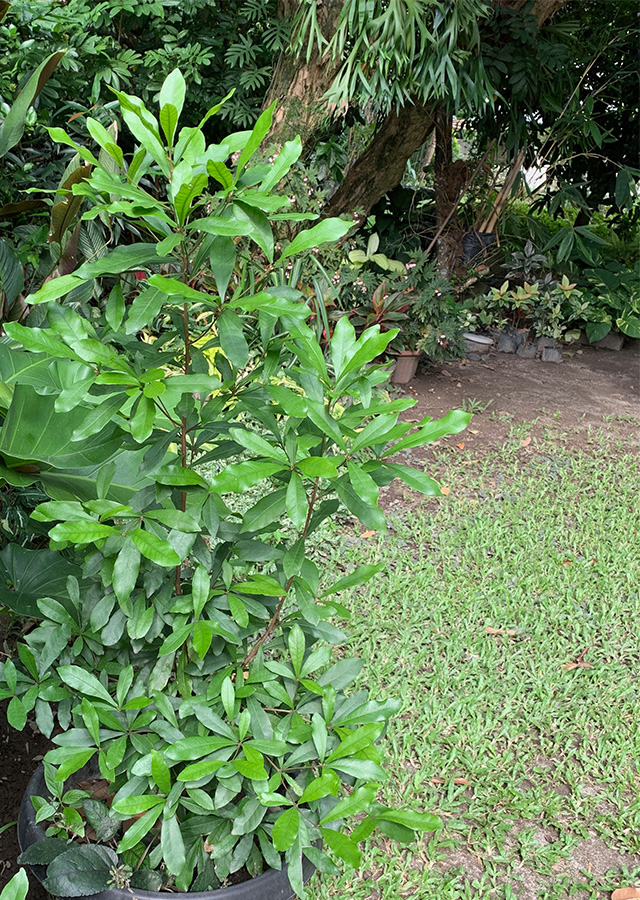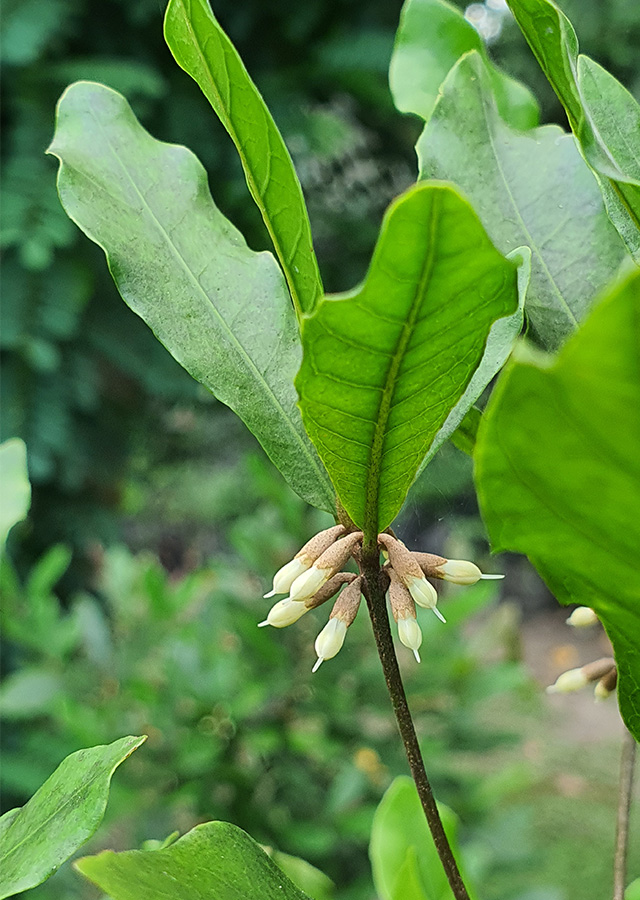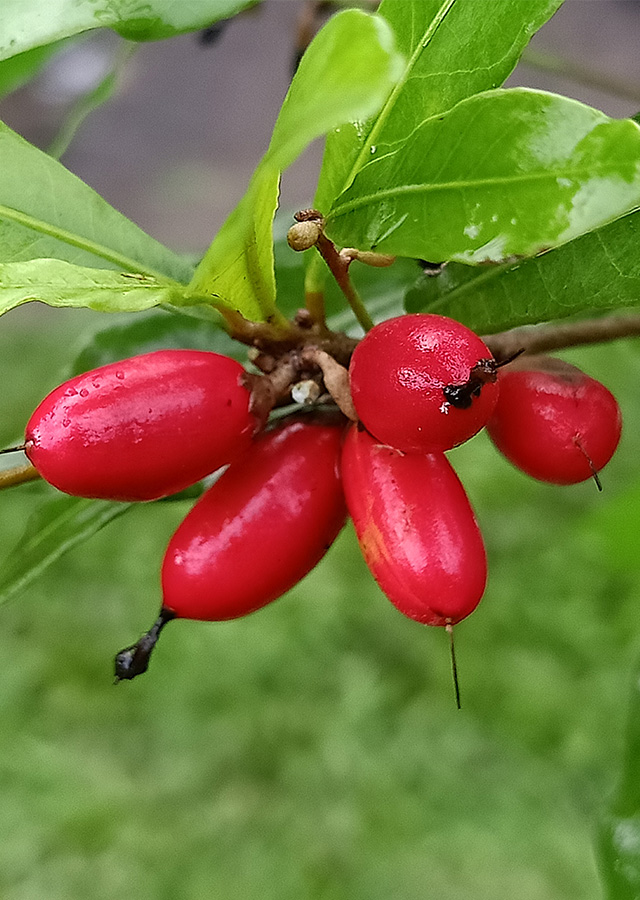Miracle Fruit
Synsepalum dulcificum (Schumach. & Thonn.) Daniell
Sapotaceae
Location in our garden
Principal



Synonym
Bakeriella dulcifica (Schumach. & Thonn.) Dubard
Bumelia dulcifica Schumach. & Thonn.
Pouteria dulcifica (Schumach. & Thonn.) Baehni
Habitus
Shrubs. A bushy, evergreen perennial shrub, grows up to 4 m high
Part Used
Leaves
Seeds
Growing Requirements
Need Shade
Habitat
Forest
Overview
Miraculous berry is a fruit native to tropical Western Central Africa and Western Africa that has a modified sour and bitter taste sensation, making acidic and bitter fruits taste sweet. If stored in the tongue, strong sweetness is felt for up to two hours every time a sour solution is tasted. These remarkable sweetening properties are due to a glycoprotein called "miraculin" It has been used in cosmetics, pharmaceuticals, and food.
Vernacular Names
Bian wei guo (Chinese), Mirakelbes (Dutch), Fruit miraculaix (French), Wunderbeere (German), Mirakuru furuutsu (Japanese), Buah ajaib (Malay), Cay than ky (Vietnamese), Frutto dei miracoli (Italian), Abayunkun (Afrikaan), Magicheskij frukt (Russian).
Agroecology
A mild to hot, muddy, tropical lowland species. Plants are frost intolerant. It can grow in full sun, but on well-drained, acidic soil with a pH of 4.5 to 5.8 under partial shade, it thrives best in light shade. For water-logging and alkaline environments, it is intolerant.
Morphology
- Leaves - alternate, clustered at the branch tip, on short petioles.
- Flowers - unisexual, white, small, solitary or in small clusters of 2–4 on slender pedicels in leaf axils.
- Fruits - ovoid to oblong berry, 2–2.5 cm long, 1 cm wide, finely pubescent, with a persistent protruding style, green turning bright red when ripe.
- Seeds is a single dark brown ellipsoid enclosed by the while fleshy translucent, insipid pulp.
Cultivation
- Propagated by cuttings and seeds.
- When about 4 - 5 years old, seedling plants will begin fruiting.
Chemical Constituents
Miraculin, essential amino acids (leucine, methionine) and non essential amino acids (glutamic acid, glycine), lupeol, lupenone, lupeol acetate, anthocyanin, flavonoids, tannins, saponins, steroids, and cardiac glycosides.
Traditional Medicinal Uses
Medicinal Uses
- This reveals positive health effects, such as antioxidants (rich of vitamins C ), anti-inflammatory, anti-hyperglycemic, and antidiabetic medicines.
- It is used in cancer treatment (chemotherapy) and radiation therapy because of its anti-neurotic properties. When going through anti-neurotic drugs and radiation therapy, cancer patients have a side effect that is bitter, metallic tastes in the mouth, and this is the reason for their health degeneration due to their inability to taste food.
Traditional Uses
- In West Africa, traditional treatments use leaves, roots, and bark for diabetes, enuresis, kidney, hyperthermia, coughing, and stomach problems.
- Leaves were used for heartburn, weak appetite, indigestion, diabetes and high blood pressure.
- It is prevalent among diabetic patients and dieters in Japan.
- In India, plant poultice was applied to the stomach, erysipelas, for abdominal complaints.
Part Used
Reference Sources
- Han, Y.C., Wu, Ju-Yu, Wang, Cing-Kung. (2019). Modulatory effects of miracle fruit ethanolic extracts on glucose uptake through the insulin signaling pathway in C2C12 mouse myotubes cells. Food Science and Nutrition. https://doi.org/10.1002/fsn3.935 25-11-2020.
- HealthBenefitsTimes.com. (No date). Miracle fruit facts and health benefits. https://www.healthbenefitstimes.com/miracle-fruit/ 22-09-2020.
- Fern, Ken. (2014). Useful Tropical Plants: Synsepalum dulciferum. http://tropical.theferns.info/viewtropical.php?id=Synsepalum+dulciferum 25-11-2020.
- Lim, T.K. (2013). Edible Medicinal and Non-Medicinal Plants: Vol. 6, Fruits. Springer. DOI 10.1007/978-94-007-5628-1_26 (pp.146-150).
- StuartXchange. (2018). Philippines Medicinal Plants. Miracle fruit. http://www.stuartxchange.com/MiracleFruit 29-07-2020.
- Tchokponhoué, D.A., N'Danikou,S., Hale, I., Van Deynze, A., and Achigan-Dako, E.G.. (2017). Early fruiting in Synsepalum dulcificum (Schumach. & Thonn.) Daniell juveniles induced by water and inorganic nutrient management. Version 1. Journal list F1000 Research. 2017; 6: 399. PMID: 28620457. doi: 10.12688/f1000research.11091.1. https://www.ncbi.nlm.nih.gov/pmc/articles/PMC5461899/ 29-07-2020.

